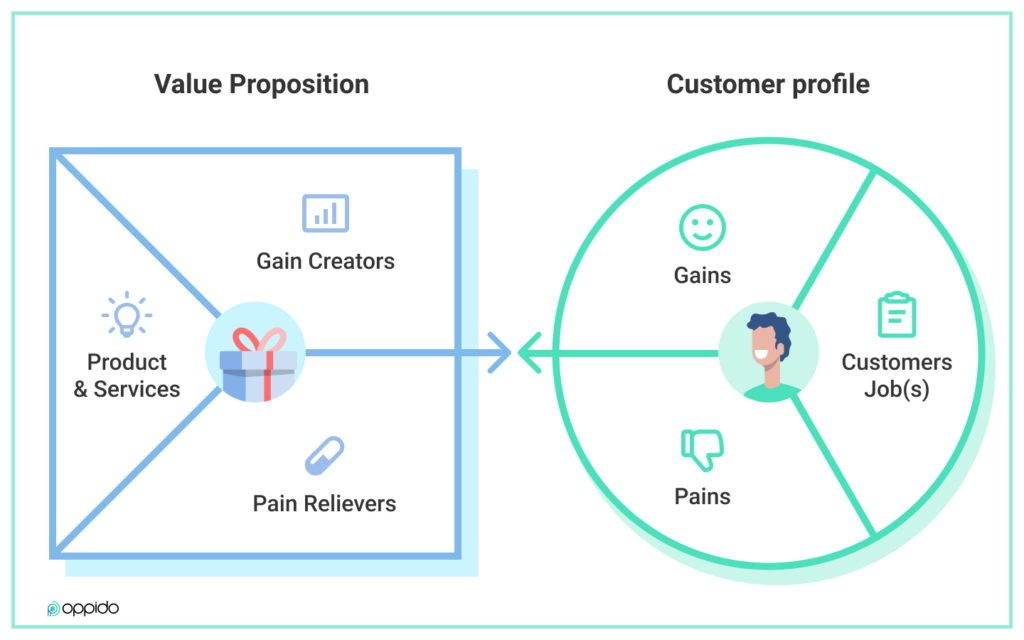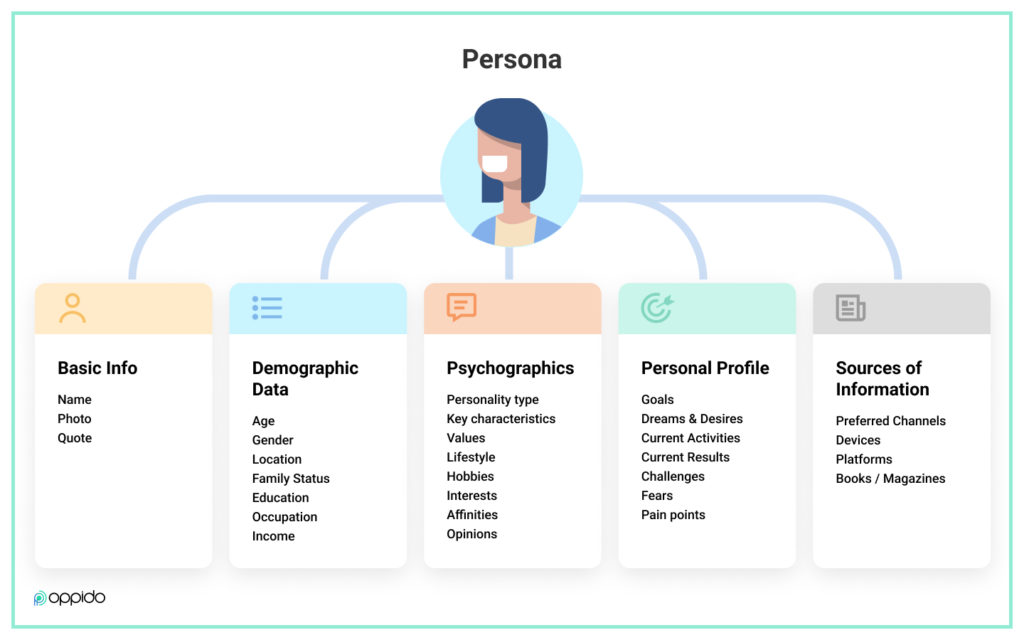The only way to design a successful marketing strategy is to understand for whom you’re making it. When it comes to creating marketing personas, understanding our customers’ insights is critical. This process is the mutual relationship between you and your key target audience. In our previous article “Marketing personas as the first step to sustainable business growth,” we’ve been looking at this topic, so if you haven’t checked it out yet, do so now!
Now that you understand what marketing personas represent let’s dive into the persona-creation process itself.
Find Your Audience Through Market Segmentation
Market segmentation is dividing a broad customer base into smaller groups of people with certain traits they share. The customer segment represents separating your target market into homogeneous subgroups of customers, which you can attract more effectively by various marketing tools. Such a segmentation process allows you to customise your content, create targeted campaigns, select preferred distribution channels, and achieve economies of scale.
Customer segmentation consists of three main parts:
- Selection of market segmentation criteria: Don’t forget to differentiate if you want to operate in the B2B or B2C market!
- Target market selection, also knows as targeting: Once you know your customer segments, decide which one you want to target to achieve your goals. Consider the target segment size, growth potential, and attractiveness (measured by competition, demand, distribution intermediates, and the like).
- Determining your segmentation strategy: The critical step is to decide on the number of market segments you want to target and what your competitive strategy will be like (considering mass marketing, differentiated marketing, concentration marketing).
There are several options when it comes to market segmentation. Some customer segmentation software is also available.
User vs customer
It’s important to emphasise there is also a difference between a customer and a user. A customer is a person performing the purchasing transaction, while a user is a person that ultimately uses your product or service. However, customers and users are not always the same person. Therefore, it’s essential to understand their concrete motivations for the buying process. Also, consider that a user has a strong influence on the customer in the purchasing process. Considering these nuances is paramount in the persona-creation process to provide your target audience with a valuable and meaningful solution.
Identify and Prioritise Your Customers’ Needs
Our previous article pointed out that marketing personas represent a bridge between the marketing and product worlds. When developing a product and setting an adequately designed marketing strategy, the following questions are essential:
“What is the added value of our product? Does our product reflect on customers’ needs? Will our customers be willing to pay for this product? Do we speak and think the same language as our customer?”

One way to find answers to such questions is to create a Value Proposition Canvas, designed by Alex Osterwalder. It represents the visualising tool to structure all your knowledge and findings of your product and your customer. This VPC helps you to comprehend and find the link between you and your target audience. It also enables you to define proper communication to approach your customers.
Step-by-Step Guide How to Bring Your Persona to Life
👫 Step 1: Define Your Target Audience
Prepare a detailed description of your key target market. You can use some of the segmentation tools mentioned above. Don’t forget always to ask clarifying and probing questions to go into more detail. When defining your perfect customer, collaborate with other departments to gain a broader perspective and as many insights as possible. You can try brainstorming or even painstorming together. It’s essential to understand customers’ motivations lying behind their purchasing behaviour.
If you target the end customers (B2C), create your personas as specific people. On the other hand, if you are more likely to address companies to which you offer your product (B2B), you might consider making a company profile and creating a persona in charge of the buying decisions process. Focus on the company’s essential aspects, such as the decision-making structure, the industry in which they operate, the number of employees, metrics they use, and other vital information to visualise the organisation.
🔎 Step 2: Find Answers
Your personas are only as good and useful as your research. Such research should be based on a combination of qualitative and quantitative data collected from multiple sources. Given the limitations of timeline, resources, and budget, consider as many options as possible to find relevant information.
Thankfully, there are numerous ways to reach your potential customers. The easiest way is to add quick pop-up forms on your website and ask your visitors to fill in. Another option is to create a user survey and send it to targeted groups via email or social media. A great source of information is the analytics on your website to uncover refined details about your customers’ behavioural and buying patterns. However, talking directly to people can be an important eye-opener. When you interact with your customers face to face, it brings you a whole new perspective to adapt to their way of thinking. Try to conduct ethnography research, focus groups, or execute discovery calls. You can find some helpful questions in our spreadsheet to make a successful discovery call to find the correct answers.
📝 Step 3: Collect the Data and Decipher Your Findings
After you’ve conducted your research, analyse and combine all gained insights with web analytics data to get your customer’s complex picture. Then categorise all ample sets of data and create your hypothesis about customers. To have a consistent and clear overview, write up a summary of each interview in a spreadsheet. Feel free to use our Oppido Personas Spreadsheet! Add or remove anything to make it the most relevant for you.
👤 Step 4: Create a Persona
Here are some of the basic information that your persona should include:

📖 Step 5: The Storytelling of Your Persona
When you look back over your analysis, you’ve probably gathered a mountain of notes. Now start to build out who exactly is the character behind your persona. Storytelling in marketing always matters. Through storytelling, we manage to deliver the backstory so we can familiarise ourselves with the character.
“Taking the time to jot down a short paragraph or two, including how your character got to the current situation, what she/he hopes to achieve and what’s stopping her/him at the moment, makes it real.“
Matt Seltzer, S2 Research
The most important thing to tell a story is to maintain consistency in every form of communication. It would help if you communicated in the manner of your key character = your persona. Whether you communicate on TV, on the web, in banners, on social media, or by email, all these channels represent a tiny story contributing to the brand’s big story. The point is that portraying the critical character’s daily life during the brand’s long-term strategy connects your customers’ emotions with your brand and product. For customers, the key to success is to find themselves in our personas.
✅ Step 6: Go Back and Redefine What’s Necessary
Now edit, condense, rewrite and restructure your findings and data collection. Don’t forget that marketing personas are not a static matter. As the market evolves, the needs and desires of your target audience change as well. Thus, it’s essential to observe and track your personas continuously and adjust them to changes.
The question is: “What can we do to understand our customers better in the long-term horizon?”
Data-driven personas have one great advantage – they are constantly updated because data collection happens on autopilot when using online analytical tools. Take enough time to review your persona in-depth and revisit your current marketing strategy to ensure it aligns with what you know of your persona now. Undoubtedly, this will pay off in the long run.
Your Free Persona Template
Marketing personas are simply a way to structure your marketing and therefore increase its efficiency. Everyone will give you ideas and suggestions on how to build them correctly. But at the end of the day, you have to ‘get on that bike’ and start riding. No one knows your business and your customers as you do. Use our marketing persona template as a starting point, and please customise it as much you want to your own needs! If you fail at first, worry not and try again. If you get stuck anywhere, contact us at info@oppido.com, and we’ll gladly help.
Further reading:
